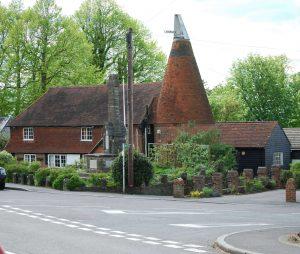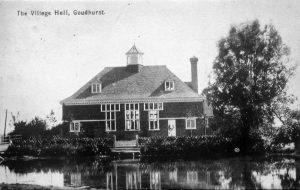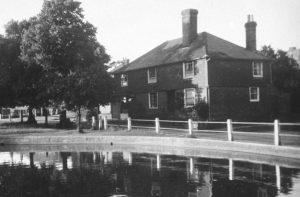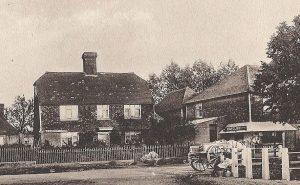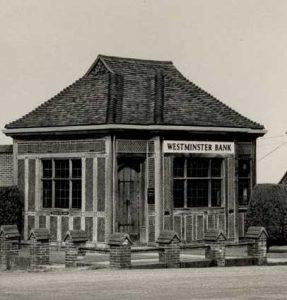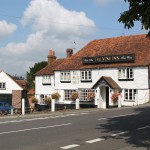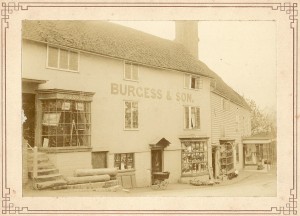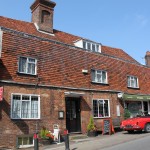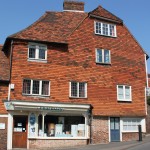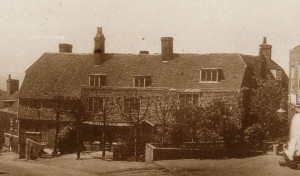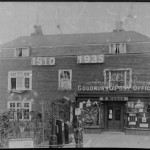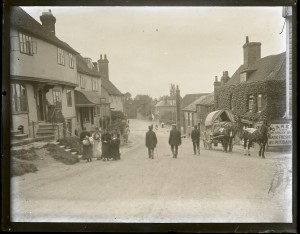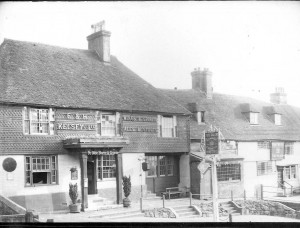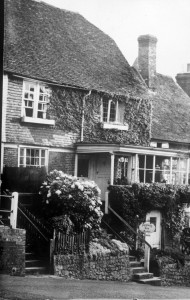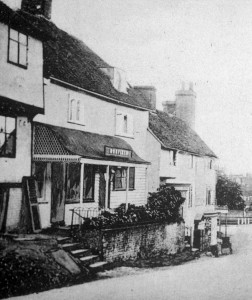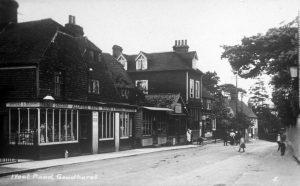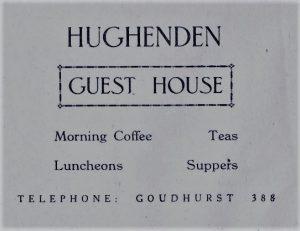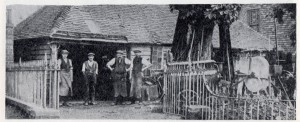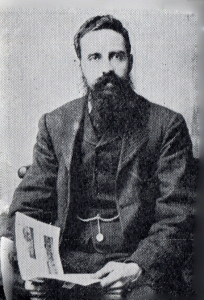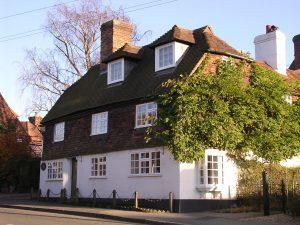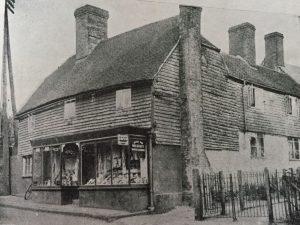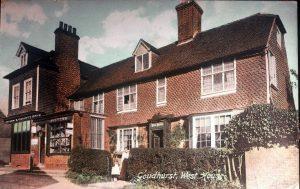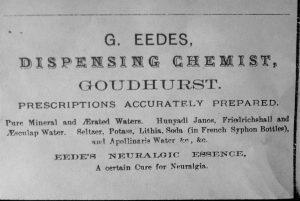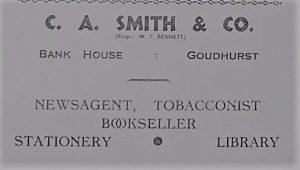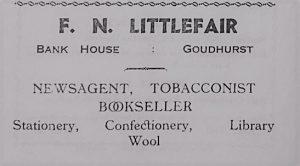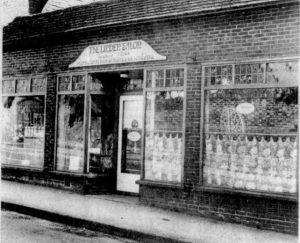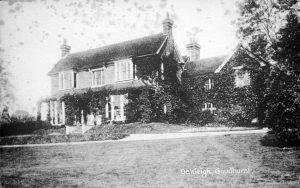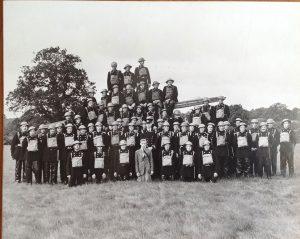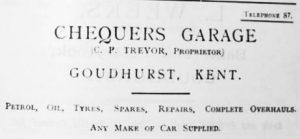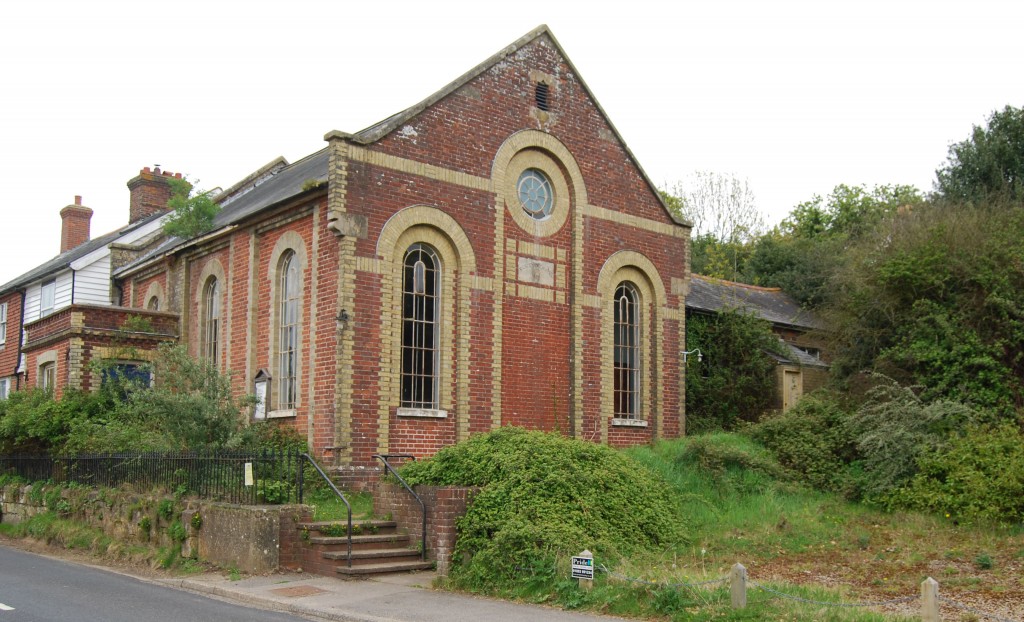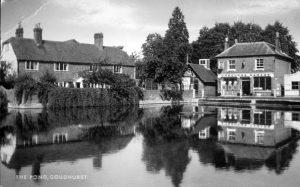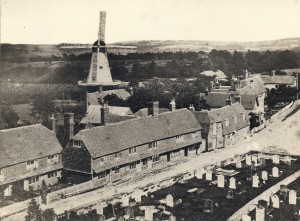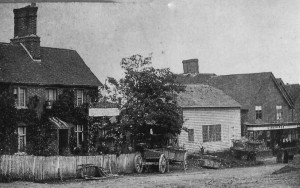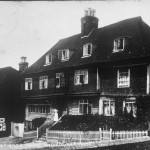
Church House – then a Temperance Hotel
Church House is easily identified at the top of the High Street by its double front doors of solid oak reached by a flight of steps from the street. The adjoining cottage has its own entrance from the High Street, but in the past it was also accessed from passages on the ground floor and the first floor of the larger house.
The house has been used for many varied purposes over the years. It began life as an old Flemish Weavers’ Cloth Hall in the 15th and 16th centuries. The large room on the lower floor is said to have housed two looms.
Much later, in 1747, Church House was used as a barracks by the newly formed Goudhurst Band of Militia, notorious for its defeat of the Hawkhurst Gang under its leader, William Sturt. The barracks was still in use during the Peninsular War, 1808-1814, and the troops were said to have been drilled on the Glebe Field. The use by the military gave the house its name at the time “The Old Barracks”.
In the 1800s the upper rooms in the house were let. An old villager, Daniel Brackfield, was born in the Old Barracks in 1823 when his parents rented three rooms there.
The 1851 census shows Jarvis Lambert and his family at Church House. They were probably living in the part that is now the cottage. Little more is known about the use of Church House until 1861 when the census shows James Couchman there with his wife Ann. James was 48 years old and Ann was 77 years old. Ann is shown as the attendant at the Reading Room. Ann and James lived in the right hand part of the property, probably the cottage, and the Reading Room, or library, was the large room on the left of the house. This is the room where the looms were once housed and where the muskets of the soldiers were hung on hooks along the walls. The rest of the house was being let out as tenements with the rooms under the roof given to poorer people of the village at low rents. One person known to give readings here was Edward Smart, a farmer living at Horden Farm. When people heard that Mr Smart was on his way, the Reading Room would be packed, such was his popularity.
The 1871 census shows that John Doust, a boot and harness maker, was living at Church House with his wife Jane and their two daughters. We know from records made by Alfred Tiffin in the Goudhurst Jubilee Book that John lived in the cottage. He used the room with a window that overlooked the High Street for his boot and harness business, and the room with a window that overlooked the churchyard he used for his “quack” chemist shop. Before moving to the High Street, John had lived and worked at Lidwells for around thirty years. John died in 1874 but Jane with her daughter, also Jane, stayed on at the cottage and traded as a tea dealer. They also had a boarder, William Button, staying with them.
By 1881 John Perry, a butcher, was running his business from the old reading room. He was living at the house with his wife Matilda, their six children and his father in law, William Apps. John had moved to Goudhurst from Pudding Lane, Maidstone. By 1891 he had left Goudhurst and was working for Prudential Assurance in Wiltshire.
In around 1885 Miss Frances Beatrice Blair, formerly of Finchcocks, bought Church House with the intention of opening a Temperance Hotel. She employed Messrs Davis and Leaney to carry out the refurbishment of the house. A coffee tavern and lodging house was opened and John Hobbs had moved in with his wife Charlotte and their family to manage it for Miss Blair. Charlotte died in 1894 and John moved from Goudhurst to Nutfield, Reigate. He died in Reigate Union Workhouse at Redhill in 1911 aged 67 years.
An advertisement in the parish magazine in 1895 shows the new proprietor of the Temperance Hotel as E. Pomphret. It was at this time that William Rootes Snr. had his cycle workshop in the basement of Church House.
By the 1901 census Alfred C Tindall, an accountant, and his wife Caroline had moved to Church House. Caroline was shown on the census as a “boarding/lodging house keeper”. Then, by 1911, Miss Elizabeth Wise had taken over as manager of the Hotel, but she didn’t stay long. By 1915 Mrs Mears was the new manager. Mr Mears worked at Coleman’s engineering shop at Trowswell Hill. When Mr Coleman moved his business to Canterbury, Mr Mears went with him taking Mrs Mears too.
Miss Blair finally gave up the hotel and sold Church House to the Lay Reader, Mr Joseph Bertram Storer. Mr Storer sold the cottage to Miss Mary Savage in November 1923. Miss Savage was an
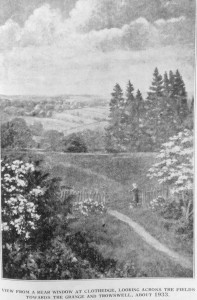
a similar painting by Mary Savage
artist and used the cottage as her studio calling it Church Studio. One of her best pictures was said to be of a gipsy caravan in the field behind Cloth Edge in Church Road. It showed the gipsy family having their tea around a glowing campfire. Then, in April 1924, Mr Storer sold the main house to Mr William Henry Delves. All the while a lock up shop was still being let in the basement of the property. Mr Verrall, the chemist, had his shop here until he moved down the High Street to the Pharmacy.
In 1925 Mrs Muriel Nicklinson, widow of the landlord at The Star and Eagle, moved here with her young family and ran the Tea Rooms. Her eldest daughter, Jessie, helped to serve the teas. Muriel left Church House when she married Charles Diprose and moved to Manor Cottage.
In 1930, Church House was put up for sale by auction. At the time some villagers thought the house might be saved for the parish to use as a permanent asset and for parochial use. So, Father George Mendham, the local Catholic priest, acquired the property by private treaty in March 1931 and offered it to the parish on advantageous terms. But, there was not sufficient support to take up his offer so the parish council was obliged to decline. Father Mendham died in 1935. The house was put up for sale and in 1936 it was advertised for £850.00.
The trade directory for 1935 shows Charles Lusted at Church House. Charles was a hairdresser and he worked there until, after cutting hair for 40 years, he retired in 1960. The same directory shows Miss Savage still living at Church Studio.
In 1949 Church House and Cottage was put up for sale by private treaty. The sale details show that although there were two parts to the property, there was still access between the house and the cottage on the ground floor and the first floor. It also shows that the lock up shop is still let.
Today Church House and Church Cottage are two separate private dwellings. Both have undergone internal refurbishment but the exteriors have remained unchanged.


